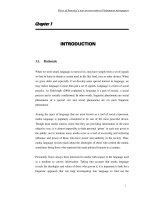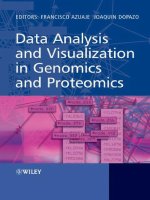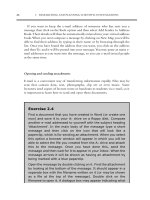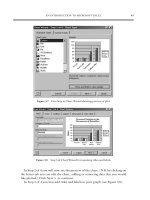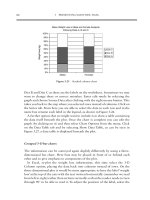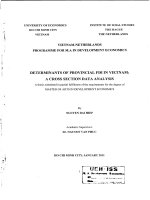Helium diffusivity in oxide nuclear fuel: Critical data analysis and new correlations
Bạn đang xem bản rút gọn của tài liệu. Xem và tải ngay bản đầy đủ của tài liệu tại đây (565 KB, 7 trang )
Nuclear Engineering and Design 330 (2018) 265–271
Contents lists available at ScienceDirect
Nuclear Engineering and Design
journal homepage: www.elsevier.com/locate/nucengdes
Helium diffusivity in oxide nuclear fuel: Critical data analysis and new
correlations
T
⁎
L. Luzzia, , L. Cogninia,b, D. Pizzocria, T. Barania, G. Pastorec, A. Schubertb, T. Wissb,
P. Van Uffelenb
a
Politecnico di Milano, Department of Energy, Nuclear Engineering Division, Via La Masa 34, 20156 Milan, Italy
European Commission, Joint Research Centre, Directorate for Nuclear Safety and Security, P.O. Box 2340, 76125 Karlsruhe, Germany
c
Idaho National Laboratory, Fuel Modeling and Simulation Department, 2525 Fremont Avenue, 83415 Idaho Falls, United States
b
A R T I C L E I N F O
A B S T R A C T
Keywords:
Inert gas behaviour
Helium behaviour
Diffusivity
Oxide fuel
Helium is relevant in determining nuclear fuel behaviour. It affects the performance of nuclear fuel both in
reactor and in storage conditions. Helium becomes important in reactor conditions when high burnups are
targeted or MOX fuel is used, whereas for storage conditions it can represent a threat to the fuel rods integrity.
The accurate knowledge of helium behaviour combined with predictive model capabilities is fundamental for the
safe management of nuclear fuel, with helium diffusivity being a critical property. For this reason, a considerable
number of separate effect experiments in the last fifty years investigated helium diffusivity in nuclear fuel. The
aim of this work is to critically review and assess the experimental results concerning the helium diffusivity.
Experimental results are critically analysed in terms of the helium introduction technique used (either infusion,
implantation or doping) and of sample characteristics (single crystal, poly-crystal or powder). Accordingly, we
derived two different correlations for the diffusivity. Clearly, each of the new correlations corresponds to a
limited range of application conditions, depending on the experimental data used to derive it. We provide
recommendations regarding the proper application conditions for each correlation (e.g., in reactor or storage
conditions).
1. Introduction
The knowledge of helium behaviour in nuclear fuel is of fundamental importance for its safe operation and storage (Olander, 1976;
Rossiter, 2012). This is true irrespectively of the particular fuel cycle
strategy adopted. In fact, both open and closed fuel cycles tend towards
operating nuclear fuel to higher burnups (i.e., keeping the fuel in the
reactor for a longer time to extract more specific energy from it), thus
implying higher accumulation of helium in the fuel rods themselves
(Rondinella et al., 2003). Moreover, considering open fuel cycles foreseeing the disposal of spent fuel, the helium production rate in the spent
nuclear fuel is positively correlated with the burnup at discharge, and
the production of helium (by α-decay of minor actinides) progresses
during storage of spent fuel (Crossland, 2012; Wiss et al., 2014). On the
other hand, closed fuel cycles imply the use of fuels with higher concentrations of minor actinides (e.g., minor actinides bearing blankets,
MABB), thus they are characterized by higher helium production rates
during operation (Crossland, 2012).
Helium is produced in nuclear fuel by ternary fissions, (n,α)-
⁎
reactions and α-decay (Botazzoli, 2011; Ewing et al., 1995; Federici
et al., 2007). After its production, helium precipitates into intra- and
inter-granular bubbles and can be absorbed/released from/to the nuclear fuel rod free volume (Booth, 1957; Matzke, 1980). Helium can
thus contribute to the fuel swelling (and eventually the stress in the
cladding after mechanical contact is established), the pressure in the
fuel rod free volume, and the gap conductance (giving feedback to the
fuel temperature) (Piron et al., 2000).
Among the properties governing the behaviour of helium in nuclear
fuel, its diffusivity and solubility govern the transport and absorption/
release mechanisms (Maugeri et al., 2009; Nakajima et al., 2011; Talip
et al., 2014a). Compared to xenon and krypton, helium presents both a
higher solubility and diffusivity in oxide nuclear fuel (Belle, 1961; Petit
et al., 2003; Rufeh et al., 1965). These high values of helium solubility
and diffusivity are responsible for its peculiar behaviour, characterized
by phenomena that are not observed for xenon and krypton (e.g., helium absorption, helium thermal re-solution from bubbles) (Donnelly
and Evans, 1991).
A considerable amount of experiments has been performed with the
Corresponding author.
E-mail address: (L. Luzzi).
/>Received 25 July 2017; Received in revised form 18 January 2018; Accepted 24 January 2018
Available online 20 February 2018
0029-5493/ © 2018 The Authors. Published by Elsevier B.V. This is an open access article under the CC BY license ( />
Nuclear Engineering and Design 330 (2018) 265–271
L. Luzzi et al.
Table 1
Summary of the experimental works considered in this overview.
Ref.
Sample
Technique of He introduction
He release measurement method
(Belle, 1961)
(Rufeh, 1964)
(Rufeh et al., 1965)
(Sung, 1967)
(Trocellier et al., 2003)
(Guilbert et al., 2004)
UO2 powder (0.16 μm)
UO2 powder (4 μm)
Infusion
Infusion
Dissolution and MSa
Dissolution and MS
UO2 single-crystal (1 μm)
UO2 poly-crystal
UO2 poly-crystal (8 μm)
Dissolution and MS
μNRAb 3He(d,p)α
NRA 3He(d,α)H
(Roudil et al., 2004)
UO2 poly-crystal (10 μm)
(Ronchi and Hiernaut, 2004)
(Martin et al., 2006)
(U0.9, 238Pu0.1) O2 poly-crystal
UO2 poly-crystal (24 μm)
(Pipon et al., 2009)
(U0.75,239Pu0.25) O2 poly-crystal
(Nakajima et al., 2011)
(Garcia et al., 2012)
UO2 single-crystal (18 μm)
UO2 poly-crystal
(Talip et al., 2014a)
(U0.999,
Infusion
Ion Implantation
Ion Implantation
Fluence 3He (m−2) = 1020
Ion Implantation
Fluence 3He (m−2) = 0.3·1020
Fluence 3He (m−2) = 3·1020
Doping
Ion Implantation
Fluence 3He (m−2) = (1.7 ± 0.06)·1020
Ion Implantation
Fluence 3He (m−2) = 5·1019
Infusion
Ion Implantation
Fluence 3He (m−2) = 1020
Doping
Pu0.001) O2 poly-crystal (10 μm)
238
NRA 3He(d,p)α
KEMS
NRA 3He(d,α)H
NRA 3He(d,p)α
KEMS
NRA 3He(d,α)H
KEMS
a
Mass Spectrometry.
NRA (Nuclear Reaction Analysis) is a nuclear method to obtain the profile of helium implanted in samples, using 3He(d,p)α and 3He(d,α)H reactions (Martin et al., 2006; Pipon et al.,
2009).
b
available diffusivities is extremely large. Nevertheless, currently used
correlations for the helium diffusivity are still derived from rough data
fitting (Garcia et al., 2012; Nakajima et al., 2011; Ronchi and Hiernaut,
2004; Roudil et al., 2004; Talip et al., 2014a) or are intended to be
upper/lower boundaries enveloping the data (Federici et al., 2007;
Ronchi and Hiernaut, 2004).
In this work, we provide a complete overview of all the experimental results obtained for helium diffusivity in oxide nuclear fuel. The
experimental results are classified according to the helium introduction
technique used. At last, we derive empirical correlations and recommend the most suitable values of the helium diffusivity in the main
cases of interest (e.g., in-pile, storage or annealing condition). The derivation of empirical correlations is complemented by an uncertainty
analysis.
goal of determining the diffusivity and solubility of helium in nuclear
fuel (Belle, 1961; Garcia et al., 2012; Guilbert et al., 2004; Hasko and
Szwarc, 1963; Martin et al., 2006; Maugeri et al., 2009; Nakajima et al.,
2011; Pipon et al., 2009; Ronchi and Hiernaut, 2004; Roudil et al.,
2004; Rufeh, 1964; Sung, 1967; Talip et al., 2014a; Trocellier et al.,
2003). In particular, several measurements have been made to determine the helium diffusivity as a function of temperature (Belle, 1961;
Garcia et al., 2012; Guilbert et al., 2004; Martin et al., 2006; Nakajima
et al., 2011; Pipon et al., 2009; Ronchi and Hiernaut, 2004; Roudil
et al., 2004; Rufeh, 1964; Sung, 1967; Talip et al., 2014a; Trocellier
et al., 2003), whereas few experiments are available to characterise
Henry’s constant,1(Belle, 1961; Blanpain et al., 2006; Hasko and
Szwarc, 1963; Maugeri et al., 2009; Nakajima et al., 2011; Rufeh, 1964;
Sung, 1967; Talip et al., 2014a).
The experimental procedures available for measuring helium diffusivity differ mainly in the way in which the helium is introduced in
the fuel samples. In particular, three introduction techniques are used:
(i) infusion (Belle, 1961; Nakajima et al., 2011; Rufeh, 1964; Sung,
1967; Maugeri et al., 2009), in which the sample is kept in a pressurized
helium atmosphere for a certain infusion time, (ii) ionic implantation
(Garcia et al., 2012; Guilbert et al., 2004; Martin et al., 2006; Pipon
et al., 2009; Roudil et al., 2004; Trocellier et al., 2003), in which a
beam of 3He+ hits and penetrates the sample, and (iii) doping (Ronchi
and Hiernaut, 2004; Talip et al., 2014a), in which α-decaying elements
are introduced in the sample, resulting in an internal source of helium.
These introduction techniques generate different helium distributions
in the samples and induce different levels of damage to the crystal
lattice of the sample (Labrim et al., 2007; Talip et al., 2014a). Depending on the introduction technique used, different measuring techniques are adopted to determine the concentration of helium introduced in the sample. A relation is then established between the
helium concentration and the diffusivity (Rufeh, 1964; Sung, 1967).
Moreover, helium diffusivity has been measured for samples with
different microstructures, i.e., single crystals, poly-crystals, and powders.
In the light of the profound differences in experimental techniques
and in microstructure of the samples, the correlations derived from
rough data fitting must be critically analysed. In fact, the spread of
2. Review of experimental results
Early measurements of the helium diffusivity in oxide nuclear fuel
have been performed since the 1960s. The growing interest in determining helium behaviour in nuclear fuel to assess its performance in
storage conditions translated in several new experiments performed in
the last twenty years. In this Section, we give an overview of all the
experimental results available in the open literature, organized in
chronological order, as reported in Table 1.
Helium can be introduced into oxide nuclear fuel samples by infusion (Nakajima et al., 2011; Rufeh et al., 1965; Sung, 1967), ion implantation (Garcia et al., 2012; Guilbert et al., 2004; Martin et al., 2006;
Pipon et al., 2009; Roudil et al., 2004; Trocellier et al., 2003) or by
doping the matrix with short-lived α-emitters (Ronchi and Hiernaut,
2004; Talip et al., 2014a). Fig. 1 shows a sketch of the different experimental techniques herein considered. Depending on the helium
introduction technique, the crystalline lattice suffers different levels of
damage. Crystalline lattices with different damage levels show different
helium behaviour. Moreover, each technique used to introduce the
helium in the sample has a corresponding specific technique to measure
the amount of helium introduced.
Belle (1961) first studied the diffusivity of helium in a UO2 powder.
After his work, the helium diffusivity in oxide nuclear fuels was estimated by Rufeh (Rufeh et al., 1965; Rufeh, 1964) and Sung (1967)
using UO2 samples (some in powder form and some single crystal) with
helium introduced through the infusion technique.
1
Early work from (Rufeh, 1964; Sung, 1967) demonstrated the validity of Henry’s law
for the system helium/oxide fuel.
266
Nuclear Engineering and Design 330 (2018) 265–271
L. Luzzi et al.
Fig. 1. Sketch of the different experimental techniques used to introduce helium in nuclear fuel samples.
important contribution to these studies arising from molecular dynamics (MD) calculations (Martin et al., 2006; Yakub et al., 2010). In
particular, Yakub et al. (2010) investigated both hypo- and hyperstoichiometric UO2. They concluded that small deviations from stoichiometry significantly accelerated helium diffusion, in agreement with
the experimental results for hyper-stoichiometric samples (Yakub et al.,
2009). Yakub suggests that non-stoichiometry increases helium diffusivity because it provides more paths for the movement of helium atoms
within the lattice. The strength of this effect appears to be more pronounced in the hypo-stoichiometric domain (Govers et al., 2009; Yakub
et al., 2010).
In the following subsections, we describe the experimental results
briefly introduced above. We categorize them depending on the technique used to introduce the helium in the sample. This is motivated by
different techniques causing different levels of damage in the crystal
lattice of the sample, which may affect the diffusivity of helium in the
sample itself (Talip et al., 2014b). Furthermore, for each experimental
result, we specify the sample microstructure.
Clearly, several other crucial aspects could contribute in explaining the spread observed in the experimental data (e.g., the specific conditions/atmospheres of the annealing experiments, the evolution of lattice damage during annealing, the potential trapping of
helium atoms at defects sites, …). Nevertheless, very limited experimental information is available to enlight these effects. We therefore
decided to keep an engineering approach and proceed with a categorization based only on the technique used to introduce the helium in
the sample.
In a more recent study, Trocellier et al. (2003) measured the
thermal diffusivity of 3He implanted in different nuclear materials.
Subsequently, also Guilbert et al. (2004) and Roudil et al. (2004) performed similar experiments in similar temperature ranges (around
1173–1373 K), both using samples of polycrystalline UO2. In particular,
Roudil et al. (2004) used two values of 3He fluence, showing that helium diffusivity is higher for lower implantation fluences. They ascribed
this behaviour to helium trapping at defects sites. Ronchi and Hiernaut
(2004) focused their activity on the mixed oxide fuel (U0.9, 238Pu0.1)O2,
exploiting the plutonium content as a doping of the sample itself (238Pu
is a short-lived, hence convenient α-emitter). This was the first experimental work about helium diffusivity in mixed oxide fuel. Martin
et al. (2006) measured helium concentrations in disks of polycrystalline
UO2, using the implantation technique. Pipon et al. (2009) applied the
implantation technique to determine the diffusivity of mixed oxide
samples with stoichiometry (U0.75, 239Pu0.25)O2.
Furthermore, Nakajima et al. (2011) determined the helium diffusivity in single crystal UO2 samples. They adopted the infusion technique and measured the helium infused concentration through a
Knudsen–effusion mass-spectrometric method (KEMS)2. Garcia et al.
(2012) measured the helium diffusivity in samples of polycrystalline
UO2 implanted at a fluence of 1020 3He·m−2. They also estimated the
diffusivity of helium at grain boundaries by comparing their results to
those obtained from single-crystal samples. Talip et al. (2014a) used
238
Pu-doped UO2 samples. They measured the helium release rate as a
function of the annealing temperature and used this information to
derive the diffusivity of helium single atoms and of helium bubbles as
well (Talip et al., 2014a). Moreover, this study leveraged on the TEM
technique, employed to obtain images of the sample before and after
the introduction of helium. TEM provides additional qualitative and
quantitative information, which is very useful for the modelling and
interpretation of the outcome of the experiment (e.g., the amount of
helium that precipitates into bubbles, the size of these bubbles and their
location) (Talip et al., 2014a).
A recent study by Talip et al. (2014b) investigated the diffusivity of
helium in non-stoichiometric UO2 fuel samples. This is of major interest
because the fuel gradually transitions into a hyper-stoichiometric
composition during storage (Wiss et al., 2014), and during operation if
high burnups are achieved (Lewis et al., 2012) or clad failure occurs.
The results of this work indicated that the diffusivity of helium is higher
in non-stoichiometric samples compared to the diffusivity in stoichiometric ones, for both single crystals and polycrystalline microstructures
(Crocombette, 2002), which is in line with the findings for Xe by
Matzke (1980).
In conclusion of this brief overview, it is worth mentioning the
2.1. Infusion
As mentioned above, there are four experimental studies in which
the infusion technique was used to introduce helium in samples (Belle,
1961; Nakajima et al., 2011; Rufeh, 1964; Sung, 1967). The results of
these experiments in terms of diffusivity are collected in Table 2 and
plotted in Fig. 2.
The experimental results obtained via the infusion technique cover a
wide range of temperatures, from 968 K to 2110 K. The spread of the
diffusivities is of one-two (1-2) orders of magnitude (Fig. 2). This experimental spread is in line with the spread of the diffusivities of other
inert gases (i.e., xenon and krypton) (Matzke, 1980).
No clear dependence of the data upon the crystalline structure of the
samples (either single crystals or powders) is observable (Fig. 2).
2.2. Implantation
Several recent experimental studies used the ion implantation
technique to introduce the helium in samples (Garcia et al., 2012;
Guilbert et al., 2004; Martin et al., 2006; Pipon et al., 2009; Roudil
et al., 2004; Trocellier et al., 2003). The results of these experiments in
2
KEMS is a method to determine the quantity of helium released during thermal
desorption (Colle et al., 2014, 2013; Talip et al., 2014a).
267
Nuclear Engineering and Design 330 (2018) 265–271
L. Luzzi et al.
Table 2
Summary of the experimental helium diffusivities in oxide fuel obtained via the infusion technique.
Ref.
Sample
Diffusivity (m2 s−1)a
Temperature (K)
Belle (1961)
UO2 powder (0.16 μm)
9.05·10−22
1.01·10−20
4.08·10−20
1.86·10−19
968
1070
1166
1268
Rufeh (1964)
Rufeh et al. (1965)
UO2 powder (4 μm)
1.5·10−17
1473
Sung (1967)
UO2 single crystal (1 μm)
6.14·10−18
9.15·10−18
12.57·10−18
1473
1623
1773
Nakajima et al. (2011)b
UO2 single crystal (18 μm)
9.50·10−10 exp[−2.05/kT]
4.88·10−10 exp[−1.93/kT]
Range: 1170–2110
Range: 1390–2070
a
b
The activation energy is expressed in electronvolt (eV). The Boltzmann constant, k, is coherently expressed in eV K−1.
The annealing of the samples has been performed with the KEMS method (Colle et al., 2014, 2013; Talip et al., 2014a).
orders of magnitude and may be influenced by the large difference in
damage accumulation (displacements per atom). Again, this experimental spread is in line with the spread of the diffusivities of other inert
gases (i.e., xenon and krypton) (Matzke, 1980).
3. Derivation of empirical correlations
The experimental diffusivities are categorized depending on the
technique used to introduce the helium in the samples. With this categorization, two clusters of data become evident: the measurements
performed via the infusion technique are in the lower region of the
diffusivity range, whereas the measurements performed via the ion
implantation and doping techniques lie in the upper region (Fig. 5). We
ascribe this major clustering of the data to the different level of lattice
damage induced by the different experimental techniques used to introduce helium in the samples. In particular, ion implantation and
doping introduce additional defects in the crystal lattice of the sample
(Talip et al., 2014b), enhancing diffusion. This conclusion is in line with
the studies showing enhanced diffusion in hypo- and hyper-stoichiometric samples (Talip et al., 2014b; Yakub et al., 2010), i.e., in samples
characterized by somewhat altered crystal lattices.
Considering the two clusters, we propose two distinct empirical
correlations for the helium diffusivity: one based on the data for infused
samples and another one based on the data for implanted and doped
samples. This implies that one correlation is suited for applications with
no (or very limited) lattice damage, whereas the other is more suited for
applications with significant lattice damage,3 which is consistent with
the difference observed between the two sets of data obtained with the
doping technique.
The proposed correlations are in the form D = D0 exp[−Q/kT].
Available data do not support the inclusion of other regressors besides
temperature (e.g., only two data include plutonium concentration and
each cluster includes only up to two microstructures).
Table 5 collects the derived fitting parameters and the uncertainties related to each fitting parameter and to the diffusivity
prediction as well.4 We can notice that the parameters for the correlation for ion implantation and doping data is affected by high
Fig. 2. Plot of the experimental helium diffusivity in oxide fuel obtained via the infusion
technique, as a function of temperature.
terms of diffusivity are collected in Table 3 and plotted in Fig. 3.
The experimental results obtained via the ion implantation technique cover a rather limited range of temperatures compared to those
derived via the infusion technique (from 968 K to 2110 K for the infused
and from 973 K to 1373 K for the implanted, respectively). The spread
of the diffusivities is around three (3) orders of magnitude. Again, this
experimental spread is in line with the spread of the diffusivities of
other inert gases (i.e., xenon and krypton) (Matzke, 1980).
All the samples used in these experiments are poly-crystals. Hence,
it is impossible to attempt a categorization of the available diffusivities
in terms of microstructure.
2.3. Doping
Only two experimental studies used the doping technique to introduce the helium in samples (Ronchi and Hiernaut, 2004; Talip et al.,
2014a). The results of these experiments in terms of diffusivity are
collected in Table 4 and plotted in Fig. 4.
The experimental results obtained via the doping cover the range of
temperature from 1320 K to 1800 K (Talip et al., 2014a), whereas the
range for the results of Ronchi and Hiernaut (Ronchi and Hiernaut,
2004) is not specified. The spread of the data is of three-four (3–4)
3
The statement that each correlation herein derived should be applied in different
situations depending on the lattice damage is meant as an indication, and not as a general
conclusion. In fact, it is difficult to derive strong conclusions considering the limited
numbers of available data. Nevertheless, this indication appears to be supported by the
available data (within the temperature range covered by the available data).
4
For those experimental data that were given already in the form of a line, we included
in the fit only the points at the extremes of the temperature range as representative of the
two degrees of freedom of the line.
268
Nuclear Engineering and Design 330 (2018) 265–271
L. Luzzi et al.
Table 3
Summary of the experimental helium diffusivities in oxide and mixed oxide fuel obtained via the ion implantation technique.
Ref.
Sample
Diffusivity (m2 s−1)a
Temperature (K)
Trocellier et al. (2003)
UO2 poly-crystal
(3.7 ± 0.74)·10−18
1273
Guilbert et al. (2004)
UO2 poly-crystal (8 μm)
6·10−17
1373
−9
Roudil et al. (2004)
UO2 poly-crystal (10 μm)
8·10
exp[−(2 ± 0.1)/kT]
4·10−10 exp[−(2 ± 0.1)/kT]c
Range: 1123–1273
Range: 1123–1273
Martin et al. (2006)
UO2 poly-crystal (24 μm)
2.25·10−17
7.6·10−17
1073
1373
Pipon et al. (2009)d
(U0.75,239Pu0.25)O2 poly-crystal
9.2·10−18
1.6·10−16
1123
1273
Garcia et al. (2012)
UO2 poly-crystal
5·10−10 exp[−(1.4 ± 0.2)/kT]
Range: 973–1373
a
b
c
d
b
The activation energy is expressed in electronvolt (eV). The Boltzmann constant, k, is coherently expressed in eV K−1.
This result is derived from a sample implanted with a helium fluence of 0.3·1020 m−2 (Roudil et al., 2004).
This result is derived from a sample implanted with a helium fluence of 3·1020 m−2 (Roudil et al., 2004).
The samples used by Pipon et al. are made of UO2 pellets with 24.5 wt% of plutonium (mainly 239Pu) (Pipon et al., 2009).
Fig. 3. Plot of the experimental helium diffusivity in oxide fuel obtained via the ion
implantation technique, as a function of temperature.
Fig. 4. Plot of the experimental helium diffusivity in oxide fuel obtained via the doping
technique, as a function of temperature.
uncertainty, related to the wide spread of the experimental data. Every
comparison between the two correlations, in terms of activation energy Q and pre-exponential factor D0, represents an indication of a
tendency. In fact, the available data are not sufficient to statistically
support conclusions. On the other hand, since we included all the
available data in the fitting procedure, these correlations are the best
available at this time.
By fitting separately the two clusters of data (i.e., data from samples
with no or very limited lattice damage and with significant lattice damage, respectively), we obtain an improved fitting quality. In fact, if
Table 4
Summary of the experimental helium diffusivities in oxide and mixed oxide fuel obtained via the doping technique.
Ref.
Sample
Ronchi and Hiernaut (2004)
(U0.9,
Talip et al. (2014a)d
(U0.999,
a
b
c
d
238
Pu0.1)O2 poly-crystal
238
Pu0.001)O2 poly-crystal (10 μm)
Diffusivity (m2 s−1)a
Temperature (K)
dpab
(8 ± 2)·10−7 exp[−(2.00 ± 0.02)/kT]
N/A
0.7c
10−7 exp[−2.59/kT]
Range: 1320–1800
0.04
−1
The activation energy is expressed in electronvolt (eV). The Boltzmann constant, k, is coherently expressed in eV K .
Displacement per atom (dpa).
As reported by Talip et al. (2014a).
Talip et al. also proposed a diffusivity for helium bubbles in the same temperature range, equal to 10−10 exp[−1.9/kT] (Talip et al., 2014a).
269
Nuclear Engineering and Design 330 (2018) 265–271
L. Luzzi et al.
Fig. 5 collects the experimental results shown in Figs. 2–4, together
with the derived correlations for each data cluster. The overall range of
temperature covered by the available data is 968–2110 K.
4. Conclusions and recommendations
In this work, we reviewed all the experimental results describing the
helium diffusivity in oxide nuclear fuels. This is a key parameter in
assessing the behaviour of nuclear fuel both in reactor and storage
conditions, irrespectively of the particular fuel cycle strategy adopted.
We categorized the available experimental data for the helium diffusivity in two groups, depending on the level of damage induced in the
lattice of the sample by the experimental technique used. The resulting
clustering of the data motivated the derivation of two distinct correlations for the helium diffusivity as a function of temperature. These
correlations have an uncertainty of a factor of ten (10) to one thousand
(1000) smaller compared to the correlation obtained by statistically
fitting all the data (with no critical assessment of the effect of the experimental technique). The foreseen adoption of these new correlations
in integral fuel performance codes will lay the foundations for a more
accurate predictive modelling of helium behaviour in nuclear fuel.
We recommend the correlation derived from data obtained by the
ion implantation and doping technique in calculations for reactor and
storage conditions. In fact, these experimental techniques introduce a
certain level of lattice damage in the sample, which is similar to that
suffered by the fuel in reactor and storage conditions. On the other
hand, we recommend the use of the correlation derived from data obtained by infusion for calculations for fresh nuclear fuel.
An important conclusion of this work is the need for new experimental data, with well characterized temperature and damage levels
(dose, concentration of doping elements or deviation from stoichiometry). In particular, the correlation derived herein recommended for
reactor and storage conditions (presumably the most important applications) is affected by uncertainties of three (3) orders of magnitude.
Since for its derivation we included all the available experimental data,
new experiments are required to reduce the uncertainty associated with
this correlation. If justified by reduced uncertainties, one could consider
developing a further improved correlation for helium diffusivity also
depending on the local fuel burnup. A further refinement will have to
be performed on the basis of data obtained from damaged samples,
since the magnitude and concentration of defects also affects the helium
diffusivity as revealed in Table 4.
The complete characterization of helium behaviour in nuclear fuel
requires the investigation of other properties besides its diffusivity. In
particular, reliable correlations for helium solubility should be developed as more data become available.
Fig. 5. Plot of the experimental helium diffusivity in oxide fuel. The measurements
performed via the infusion technique (green) are clustered in the lower part of the plot,
whereas in the upper part emerges a cluster of those measurements performed via the ion
implantation (blue) and doping (red) technique. This clustering is ascribed to the different
level of lattice damage caused to the sample by the different experimental techniques.
Each cluster is fitted by a distinct correlation (magenta and light green). (For interpretation of the references to colour in this figure legend, the reader is referred to the web
version of this article.)
data clustering is disregarded, the fit of all the data has a coefficient of
determination of the linear regression R2 = 0.43.
The best estimate correlation for the cluster of data with no or very
limited lattice damage is
D = 2.0·10−10exp[−2.12/ kT ]
(1)
whereas for the cluster of data with significant lattice damage we get
D = 3.3·10−10exp[−1.64/ kT ]
(2)
We calculated the uncertainty on the prediction of the diffusivity by
propagating the uncertainty of each fitting parameter. The resulting
uncertainty is of the order of a factor of ten (×10) for the correlation
relative to no or very limited lattice damage (Eq. (1)) and of a factor of
one thousand (×1000) for the correlation relative to significant lattice
damage (Eq. (2)). For comparison, the uncertainty of the fit made with
all the data is a factor of ten thousands (×10,000). The proposed categorization therefore allows for a reduction of uncertainties of a factor
of one thousand/ten, respectively.
Table 5
Summary of the information concerning the fit of correlations. The form is Log D = Log D0 − Q/kT Log e. For each fitting parameter, we report in round brackets the
confidence intervals at 95% confidence level.
Data (Ref.)
Log D0 (m2 s−1)
Q (eV)a
Range (K)
R2
Infusion
(Belle, 1961; Nakajima et al., 2011;
Rufeh et al. 1965; Rufeh, 1964; Sung, 1967)
Ion implantation
(Garcia et al., 2012; Guilbert et al., 2004;
Martin et al., 2006; Pipon et al., 2009;
Roudil et al., 2004; Trocellier et al., 2003)
and doping
(Ronchi and Hiernaut, 2004; Talip et al., 2014a)
−9.7 (−11, −8.4)
2.12 (1.77, 2.56)
968–2110
0.93
−9.5 (−13, −5.8)
1.64 (0.74, 2.56)
973–1800
0.52b
The corresponding values of the activation energy Q (J) are 3.4·10−17 and 2.6·10−17, respectively.
This value of R2 does not seem fully satisfactory. Nevertheless, we still choose to report this fit since it includes all the data available in the literature. Further
refinement of this correlation is of major interest, once more data will become available.
a
b
270
Nuclear Engineering and Design 330 (2018) 265–271
L. Luzzi et al.
Acknowledgments
2007. Thermal evolution of the vacancy defects distribution in 1 MeV helium implanted sintered UO2. Nucl. Instrum. Methods Phys. Res. Sect B Beam Interact. Mater.
Atoms 261, 883–887. />Lewis, B.J., Thompson, W.T., Iglesias, F.C., 2012. Fission product chemistry in oxide fuels.
In: Konings, R.J.M. (Ed.), Comprehensive Nuclear Materials. Elsevier Inc., pp.
515–546. />Martin, G., Garcia, P., Labrim, H., Sauvage, T., Carlot, G., Desgardin, P., Barthe, M.F.,
Piron, J.P., 2006. A NRA study of temperature and heavy ion irradiation effects on
helium migration in sintered uranium dioxide. J. Nucl. Mater. 357, 198–205. http://
dx.doi.org/10.1016/j.jnucmat.2006.06.021.
Matzke, H., 1980. Gas release mechanisms in UO2 – a critical review. Radiat. Eff. 53,
219–242.
Maugeri, E., Wiss, T., Hiernaut, J.P., Desai, K., Thiriet, C., Rondinella, V.V., Colle, J.Y.,
Konings, R.J.M., 2009. Helium solubility and behaviour in uranium dioxide. J. Nucl.
Mater. 385, 461–466. />Nakajima, K., Serizawa, H., Shirasu, N., Haga, Y., Arai, Y., 2011. The solubility and diffusion coefficient of helium in uranium dioxide. J. Nucl. Mater. 419, 272–280. http://
dx.doi.org/10.1016/j.jnucmat.2011.08.045.
Olander, D.R., 1976. In: Fundamental Aspects of Nuclear Reactor Fuel Elements, http://
dx.doi.org/10.1016/0022-3115(77)90226-4.
Petit, T., Freyss, M., Garcia, P., Martin, P., Ripert, M., Crocombette, J.P., Jollet, F., 2003.
Molecular modelling of transmutation fuels and targets. J. Nucl. Mater. 320,
133–137. />Pipon, Y., Raepsaet, C., Roudil, D., Khodja, H., 2009. The use of NRA to study thermal
diffusion of helium in (U, Pu)O2. Nucl. Instrum. Methods 267, 2250–2254. http://dx.
doi.org/10.1016/j.nimb.2009.03.025.
Piron, J.P., Pelletier, M., Pavageau, J., 2000. Fission Gas Behaviour in Water Reactor
Fuels. OECD/NEA.
Ronchi, C., Hiernaut, J.P., 2004. Helium diffusion in uranium and plutonium oxides. J.
Nucl. Mater. 325, 1–12. />Rondinella, V.V., Wiss, T., Cobos, J., Hiernaut, H., 2003. Studies on spent fuel alterations
during storage and radiolysis effects on corrosion behaviour using alpha-doped UO2,
in: 9th Conference on Radioactive Waste Management and Environmental
Remediation. p. 4593.
Rossiter, G., 2012. Understanding and modelling fuel behaviour under irradiation. In:
Nuclear Fuel Cycle Science and Engineering. Woodhead Publishing Limited, pp.
396–426.
Roudil, D., Deschanels, X., Trocellier, P., Jégou, C., Peuget, S., Bart, J.M., 2004. Helium
thermal diffusion in a uranium dioxide matrix. J. Nucl. Mater. 325, 148–158. http://
dx.doi.org/10.1016/j.jnucmat.2003.11.012.
Rufeh, F., Olander, D.R., Pigford, T.H., 1965. The solubility of helium in uranium dioxide.
Nucl. Sci Eng.
Rufeh, F., 1964. Solubility of Helium in Uranium Dioxide (MS Thesis). Univ. Calif.
Sung, P., 1967. Equilibrium Solubility and Diffusivity of Helium in Single-crystal Uranium
Dioxide. Univ. Washingt.
Talip, Z., Wiss, T., Di Marcello, V., Janssen, A., Colle, J.Y., Van Uffelen, P., Raison, P.,
Konings, R.J.M., 2014a. Thermal diffusion of helium in 238Pu-doped UO2. J. Nucl.
Mater. 445, 117–127. />Talip, Z., Wiss, T., Maugeri, E.A., Colle, J.Y., Raison, P.E., Gilabert, E., Ernstberger, M.,
Staicu, D., Konings, R.J.M., 2014b. Helium behaviour in stoichiometric and hyperstoichiometric UO2. J. Eur. Ceram. Soc. 34, 1265–1277. />jeurceramsoc.2013.11.032.
Trocellier, P., Gosset, D., Simeone, D., Costantini, J.M., Deschanels, X., Roudil, D.,
Serruys, Y., Grynszpan, R., Saudé, S.E., Beauvy, M., 2003. Application of nuclear
reaction geometry for 3He depth profiling in nuclear ceramics. Nucl. Instrum.
Methods Phys. Res. Sect B Beam Interact. Mater. Atoms 206, 1077–1082. http://dx.
doi.org/10.1016/S0168-583X(03)00914-5.
Wiss, T., Hiernaut, J.P., Roudil, D., Colle, J.Y., Maugeri, E., Talip, Z., Janssen, A.,
Rondinella, V., Konings, R.J.M., Matzke, H.J., Weber, W.J., 2014. Evolution of spent
nuclear fuel in dry storage conditions for millennia and beyond. J. Nucl. Mater. 451,
198–206. />Yakub, E., Ronchi, C., Staicu, D., 2010. Diffusion of helium in non-stoichiometric uranium
dioxide. J. Nucl. Mater. 400, 189–195. />03.002.
Yakub, E., Ronchi, C., Staicu, D., 2009. Computer simulation of defects formation and
equilibrium in non-stoichiometric uranium dioxide. J. Nucl. Mater. 389, 119–126.
/>
This work was supported by the GENTLE Project at the Directorate
for Nuclear Safety and Security (JRC-Karlsruhe, Germany) under grant
agreement No 198236, and has received funding from the Euratom
research and training programme 2014-2018 through the INSPYRE
project under grant agreement No 754329. This research contributes to
the Joint Programme on Nuclear Materials (JPNM) of the European
Energy Research Alliance (EERA), in the specific framework of the
COMBATFUEL Project. The work is also part of the R&D activities
carried out by Politecnico di Milano in the framework of the IAEA
Coordinated Research Programme FUMAC (CRP-T12028, Fuel modelling in accident conditions).
The submitted manuscript has been authored by a contractor of the
U.S. Government under Contract DE-AC07-05ID14517. Accordingly,
the U.S. Government retains a non-exclusive, royalty free license to
publish or reproduce the published form of this contribution, or allow
others to do so, for U.S. Government purposes.
References
Belle, J., 1961. Uranium Dioxide: properties and nuclear applications. Library (Lond).
Blanpain, P., Lippens, M., Schut, H., Federov, A.V., Bakker, K., 2006. The HARLEM
Project, Helium solubility in UO2. Work. MMSNF-5, Nice, Fr.
Booth, A.H., 1957. A method of calculating fission gas diffusion from UO2 fuel and its
application to the X-2-f loop test. At. Energy Canada Ltd. Chalk River Proj. Res. Dev.
Rep. AECL-496, pp. 1–23.
Botazzoli, P., 2011. Helium Production and Behaviour in LWR Oxide Nuclear Fuels
(Ph.D. Thesis). Politec. di Milano, Italy.
Colle, J.-Y., Freis, D., Benes, O., Konings, R.J.M., 2013. Knudsen effusion mass spectrometry of nuclear materials: applications and developments. ECS Trans. 46, 23–38.
/>Colle, J.-Y., Maugeri, E.A., Thiriet, C., Talip, Z., Capone, F., Hiernaut, J.-P., Konings,
R.J.M., Wiss, T., 2014. A mass spectrometry method for quantitative and kinetic
analysis of gas release from nuclear materials and its application to helium desorption
from UO2 and fission gas release from irradiated fuel. J. Nucl. Sci. Technol. 51,
700–711.
Crocombette, J.-P., 2002. Ab initio energetics of some fission products (Kr, I, Cs, Sr and
He) in uranium dioxide. J. Nucl. Mater. 305, 29–36. />S0022-3115(02)00907-8.
Crossland, I., 2012. Nuclear fuel cycle science and engineering. Woodhead Publishing
Limited.
Donnelly, S.E., Evans, J.H., 1991. Fundamental aspects of inert gases in solids.
Ewing, R.C., Weber, W.J., Clinard, F.W., 1995. Radiation effects in nuclear waste forms
for high-level radioactive waste. Prog. Nucl. Energy 29, 63–127. />10.1016/0149-1970(94)00016-Y.
Federici, E., Courcelle, A., Blanpain, P., Cognon, H., 2007. Helium production and behavior in nuclear oxide fuels during irradiation in LWR. Proc. Int. LWR Fuel Perform.
Meet. San Fr. Calif., pp. 664–673.
Garcia, P., Martin, G., Desgardin, P., Carlot, G., Sauvage, T., Sabathier, C., Castellier, E.,
Khodja, H., Barthe, M.F., 2012. A study of helium mobility in polycrystalline uranium
dioxide. J. Nucl. Mater. 430, 156–165. />06.001.
Govers, K., Lemehov, S., Hou, M., Verwerft, M., 2009. Molecular dynamics simulation of
helium and oxygen diffusion in UO2 ± x. J. Nucl. Mater. 395, 131–139. .
org/10.1016/j.jnucmat.2009.10.043.
Guilbert, S., Sauvage, T., Garcia, P., Carlot, G., Barthe, M.F., Desgardin, P., Blondiaux, G.,
Corbel, C., Piron, J.P., Gras, J.M., 2004. He migration in implanted UO2 sintered
disks. J. Nucl. Mater. 327, 88–96. />Hasko, S., Szwarc, R., 1963. Noble gas solubility and diffusion in UO2. AEC, Div. React.
Dev. Washingt.
Labrim, H., Barthe, M.F., Desgardin, P., Sauvage, T., Corbel, C., Blondiaux, G., Piron, J.P.,
271
